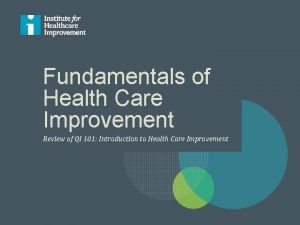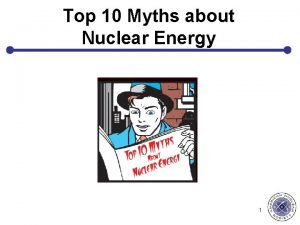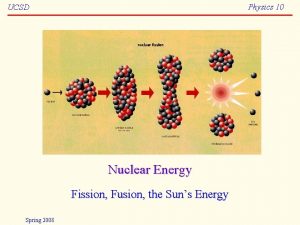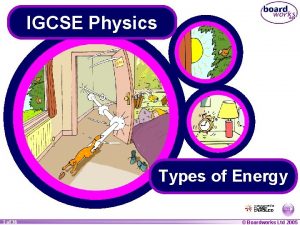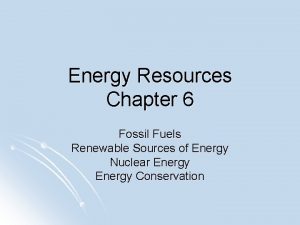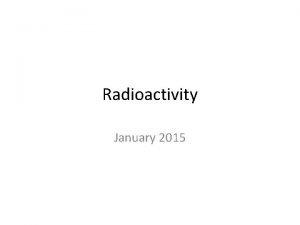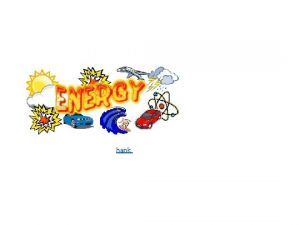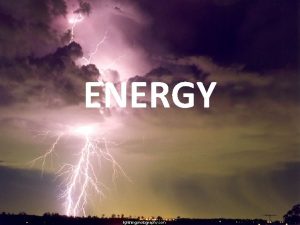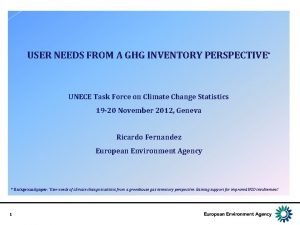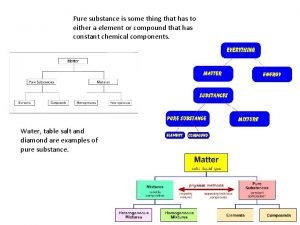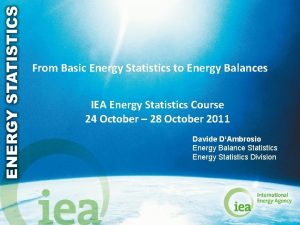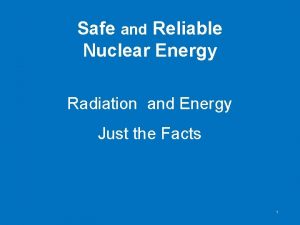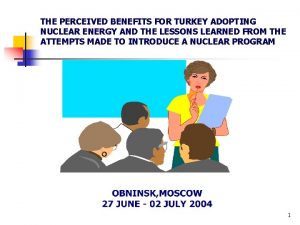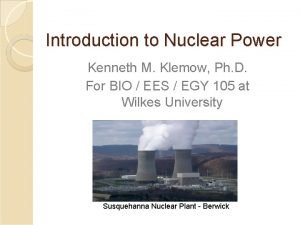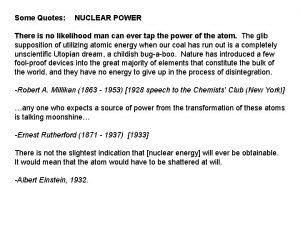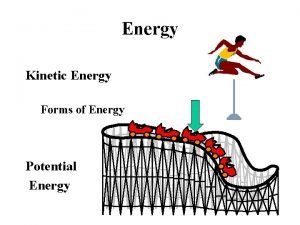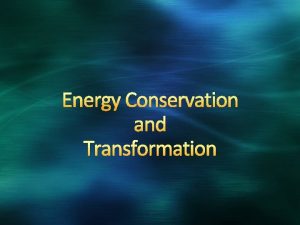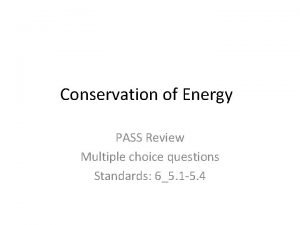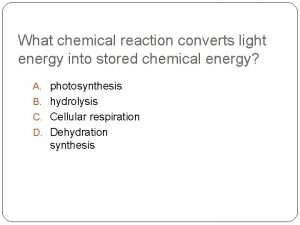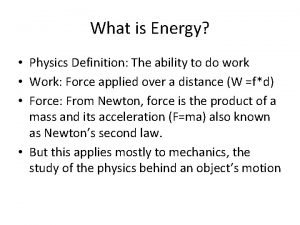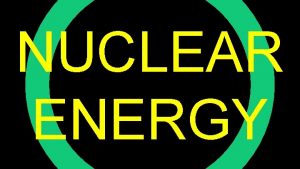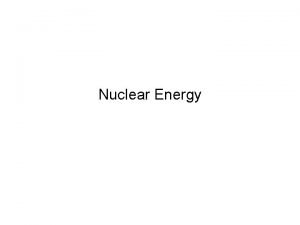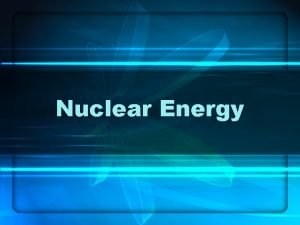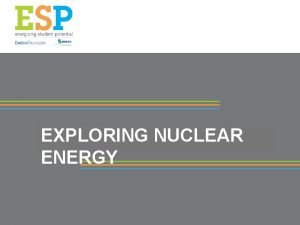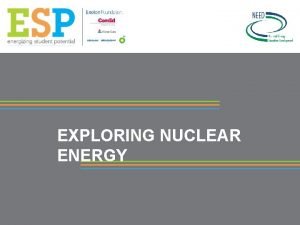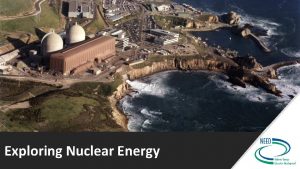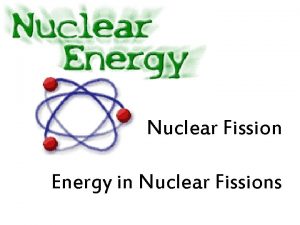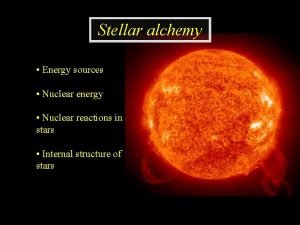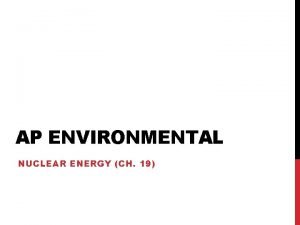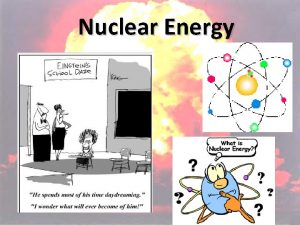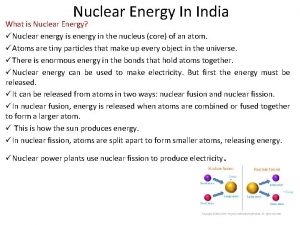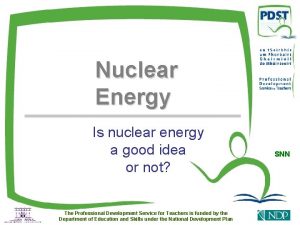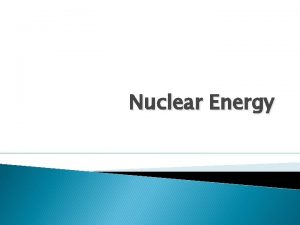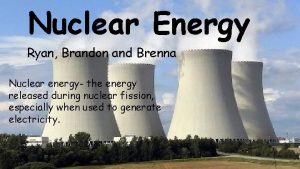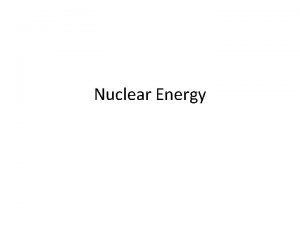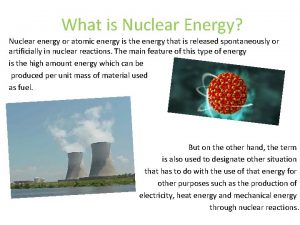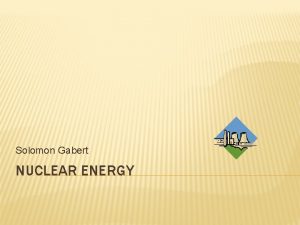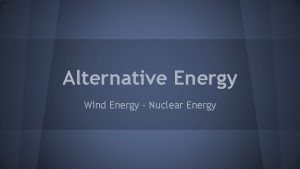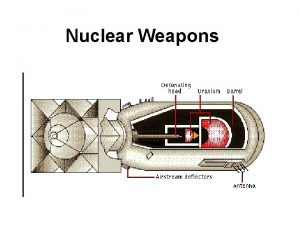GEHitachi Nuclear Energy Nuclear 101 Introduction to Nuclear




























































- Slides: 60

GE-Hitachi Nuclear Energy Nuclear 101 Introduction to Nuclear Technology John F. Zino Engineering Manager Stability & Radiological Nuclear Analysis COE GE-Hitachi Nuclear Energy Wilmington, NC 28402 GEWN Meeting June 3, 2010 GEH Proprietary – Internal

Nuclear 101 Ø Ø Brief History of Nuclear Industry The Nuclear Fuel Cycle Fundamentals of Nuclear Technology Fuel Cycle Nuclear Safety Events “In science, things should be made as simple as possible – but no simpler. ” - Albert Einstein GEH Proprietary – Internal

A Brief History of the Nuclear Industry GEH Proprietary – Internal

A Brief History of the Nuclear Industry 1930 1940 1950 1960 1970 1980 1990 2000 2010 1933 The idea of chain reaction via neutron was proposed by Leó Szilárd. Patent applied for a simple nuclear reactor in 1934. Leó Szilárd initiated a letter signed by Albert Einstein to President Roosevelt regarding the potential uses of Uranium. GEH Proprietary – Internal

A Brief History of the Nuclear Industry 1930 1940 1950 1960 1970 1980 1990 2000 2010 1938 Nuclear fission proven using Uranium bombarded by “neutron howitzer” Otto Hahn and Fritz Strassmann succeeded in identifying fission fragments in a sample of Uranium that had been exposed to Neutrons. GEH Proprietary – Internal

A Brief History of the Nuclear Industry 1930 1940 1950 1960 1970 1980 1990 2000 2010 1942 Chicago Pile 1 Sustains Chain Reaction (first artificial reactor) led by Enrico Fermi. GEH Proprietary – Internal

A Brief History of the Nuclear Industry 1930 1940 1950 1960 1970 1980 1990 2000 2010 1946 US Atomic Energy Commission Established to foster and control the peace time development of atomic science and technology. GEH Proprietary – Internal

A Brief History of the Nuclear Industry 1930 1940 1950 1960 1970 1980 1990 2000 2010 1951 EBR-1 the worlds first nuclear power plant generates 100 kw (rated for 200 kw). GEH Proprietary – Internal

A Brief History of the Nuclear Industry 1930 1940 1950 1960 1970 1980 1990 2000 2010 1954 Obninsk Nuclear Power Plant in the Soviet Union went on line. This was the first nuclear power station built for civil purposes, It produced around 5 MW (electrical). GEH Proprietary – Internal

A Brief History of the Nuclear Industry 1930 1940 1950 1960 1970 1980 1955 USS Nautilus launched. GEH Proprietary – Internal 1990 2000 2010

A Brief History of the Nuclear Industry 1930 1940 1950 1960 1970 1980 1990 2000 2010 1957 Shippingport Atomic Power station (first commercial US reactor) on line. This plant was capable of generating 60 Mw(e). GEH Proprietary – Internal

A Brief History of the Nuclear Industry 1930 1940 1950 1960 1970 1980 1990 2000 2010 1960’s to 1980’s Boom years for nuclear construction generation capability rose from less than 1 Gw to over 100 Gw. GEH Proprietary – Internal

A Brief History of the Nuclear Industry 1930 1940 1950 1960 1970 1980 1990 2000 2010 1974 Energy Reorganization Act signed, AEC divided into DOE and NRC. GEH Proprietary – Internal

A Brief History of the Nuclear Industry 1930 1940 1950 1960 1970 1980 1990 2000 1979 TMI Unit 2 experienced partial core meltdown. GEH Proprietary – Internal 2010

A Brief History of the Nuclear Industry 1930 1940 1950 1960 1970 1980 1979 INPO formed following TMI accident. GEH Proprietary – Internal 1990 2000 2010

A Brief History of the Nuclear Industry 1930 1940 1950 1960 1970 1980 1990 2000 2010 1986 Reactor #4 in the Chernobyl complex experienced a power excursion that resulted in a steam and chemical explosion. GEH Proprietary – Internal

A Brief History of the Nuclear Industry 1930 1940 1950 1960 1970 1980 1999 Criticality accident at JCO facility in Japan. GEH Proprietary – Internal 2000 2010

A Brief History of the Nuclear Industry 1930 1940 1950 1960 1970 1980 1990 2000 2010 2002 Davis Besse head degradation identified. Plant shut down for two years for repair. GEH Proprietary – Internal

The Nuclear Fuel Cycle GEH Proprietary – Internal

Uranium Two principal isotopes of Uranium are: • U-235 • U-238 Both have 92 protons Differ in # of neutrons (3) Uranium (natural): • U-235 (~1%) • U-238 (~99%) Uranium: • Actinide element Uranium (enriched): • Heavy metal (~19 g/cc) • U-235 (~5%) • Radioactive (emits radiation) • U-238 (~95%) • Carcinogenic • Fissile (undergoes fission) GEH Proprietary – Internal

Isotopes # Protons # Neutrons GEH Proprietary – Internal

Where Does Uranium Come From ? GEH Proprietary – Internal

Nuclear Fuel Cycle GLE scope GNF scope Fuel Cycle scope Out of scope Fuel fabrication • • BWR Fresh Fuel BWR RU Fuel CANDU Fuel MOX Fuel Nuclear plant operation Re-conversion to UO 2 powder Spent fuel storage Core design Fuel design UF enrichment UF 6 enrichment 6 Conversion to UF 6 gas Spent fuel reprocessing (Advanced technologies) Uranium mining GEH Proprietary – Internal

Uranium Mine Types Open Pit Uranium Mine Underground Uranium Mine GEH Proprietary – Internal

Natural Enriched Uranium (< 1% U 235) GEH Proprietary – Internal

GEH Proprietary – Internal

GEH Proprietary – Internal

Enrichment Evolution of Technology Gaseous Diffusion Marketplace outlook: • Supply short beginning 2013 -2015 • Aging technology exiting • New capacity deployment issues Centrifuge Strategic partnerships: • SILEX license rights acquired in 2006 Laser • Joint venture with Hitachi & Cameco Lower Cost • Positions Global Laser Enrichment at front end of the fuel cycle GEH Proprietary – Internal

Enriched Fuel Production Enriche d UF 6 gas GEH Proprietary – Internal

Fundamentals of Nuclear Technology GEH Proprietary – Internal

The Nuclear Steam Cycle GEH Proprietary – Internal

Core Recirculation Flow Path Nuclear Fuel Inside Reactor Core (Uranium) GEH Proprietary – Internal

Fission in Uranium Fission Chain Reaction Neutrons emitted from fission with high energy; must be slowed down to cause more fissions Fission Radiation Moderation* (slowing down) Radiation Neutron Fission Fragments Uranium *Water is a good moderator GEH Proprietary – Internal Fission

Chemical vs. Nuclear Chemical Heat Source Ø Ø Ø Combustion of hydrocarbons Chemical reaction Occurs outside the nucleus Ignition source needed Shutdown by removing ignition source CHx + O 2 H 2 O + CO 2 + Energy ~104 cal per gram of fuel consumed Nuclear Heat Source Ø Ø Ø Splitting of uranium atoms Nuclear reaction Occurs inside the nucleus No ignition source needed Shutdown by removing neutrons (n) from process 235 U 144 Ba + 90 Kr + 2 n + +n Energy ~1010 cal per gram of fuel consumed GEH Proprietary – Internal

Uranium Dioxide (UO 2) Uranium used in nuclear fuel is in the form of uranium dioxide (UO 2): ØCeramic material ØHigh thermal conductivity ØGood mechanical properties ØInterstitial void spaces in ceramic allows room for fission product gases to collect and be trapped Pellets ~ 10 -11 g/cc Powder ~ 2 -4 g/cc GEH Proprietary – Internal

Nuclear Fuel Bundle UO 2 is contained in a fuel pellet Pellets are loaded into fuel rods Fuel rods are assembled into fuel bundles Fuel pellet ~ 10 g Fuel rod contains ~ 350 pellets GEH Proprietary – Internal Fuel bundle contains ~ 100 rods

Reactor Core Reactor core contains: ~750 bundles or ~70, 000 rods or ~25 MM pellets GEH Proprietary – Internal

Reactor Core Lattice Fuel Lattice Characteristics: • Fuel pins arranged on a square pitch (~ 1 cm) • Bundles arranged on a square pitch (6 in. ) • Water between fuel pins • Water between bundles • Local Power Range Monitor Detectors • Control Rod Blades Fission neutrons emitted from one fuel pin travel through the water moderator, slow down and cause fission in other fuels pins Neutrons from fission can travel several inches to several feet in the reactor lattice GEH Proprietary – Internal

Control Blades The primary way to control the fission process is by removing neutrons from the reactor core thereby making them less available to continue the fission process. Bottom Entry Control blades containing Boron are inserted in between fuel bundles and are used to control the nuclear fission process. GEH Proprietary – Internal

Void/Temperature Effect A second way to control the fission process is through Void/Temperature Feedback: • As fuel temperature increases, circulating water is heated and begins to boil • Boiling water has a lower effective water density • Lower water density reduces neutron moderation (not as much slowing down of neutrons) • Reduction in neutron moderation reduces fission process • Reduction in fission process decreases fuel energy release • Fuel temperature decreases! Void/Temperature Feedback Mechanism Makes Boiling Water Reactors Inherently Safe to Operate GEH Proprietary – Internal

BWR Power/Flow Control During plant start-up, control blades removed, fission rate increases, power increases. Blades removed until neutron population reaches steadystate condition. During power ascension, regulate core recirculation flow to increase/decrease power level as needed. GEH Proprietary – Internal

GE BWR History 1969 -1970 Late 1950’s 1963 -1969 1971 -1973 1972 -1990 1978 -1994 1981 -1987 1996 -1997 2010 > GEH Proprietary – Internal

• High system pressure (3000 psig) • Lower system pressure (1000 psig) • Separate secondary system • Direct steam feed to turbine GEH Proprietary – Internal

Nuclear Factoids… Typical BWR: • Fuel cycle 12 -24 months in length • 650 -800 bundles in core (~150 tons of uranium!) • 3500 -4500 Mw(th) • 443 operating reactors world-wide Ø 91 based on GE design • 103 operating reactors in the U. S. Ø 34 based on GE design • ~20% U. S. electrical generating capacity GEH Proprietary – Internal • Re-fuel ~ 1/3 to 1/2 of the core each shutdown • Re-license with NRC each time fuel is changed

*But What About The Waste? • Storage in pools or above ground in dry casks • Waste well contained in fuel rods • Spontaneously decays • Initial toxicity decreases rapidly • Few meters of earth stops the radiation • Spent fuel can be reprocessed • The volume of waste is small *Larry Foulke, “The World’s Energy Future and the Role of Nuclear Power”, Wilmington Area Local ANS Section Meeting, Oct. 22, 2008. GEH Proprietary – Internal

Waste Volume Comparison Ratio Source *Tons/year Waste: Nuclear Waste 2, 530 1 152, 000 60 Coal power plants - ash 66 million 26, 000 Municipal waste 230 million 91, 000 Human waste 277 million 109, 000 Cattle waste 480 million 190, 000 Nuclear power - high level waste Kleenex *Selected U. S. Annual Waste Generation Comparisons (Ref: Heaberlin, A Case for Nuclear Generated Electricity, Battelle Press, 2004) GEH Proprietary – Internal

Addressing Spent Fuel Concerns Integrated Facility: • Passively safe advanced PRISM reactor…generates electricity • Cost Competitive • Closes Fuel Cycle • Creates Useful Uranium • Modular and scalable • Proliferation resistant • Ready for commercial development Advanced Recycling Reactor Nuclear Fuel Recycling Facility GEH Proprietary – Internal

Fuel Cycle Nuclear Safety Events GEH Proprietary – Internal

Uncontrolled Chain Reaction • Serious consequences of not controlling chain reaction • Characterized by a release of: Ø Ø Large amounts of ionizing radiation Large amount of energy (heat) • Energy release can rupture tanks, vessels or equipment • Radiation levels would kill workers in immediate area • Significant contamination to facility • Release of radioactive gases to environment • To date there have been 22 process related accidents: Ø Ø Ø 19 occurred from 1945 - 1978 1 from 1979 – 1996 2 since 1997 Ø Last accident in the U. S. was in 1978 at Idaho Chemical Processing Plant GEH Proprietary – Internal

JCO Facility • Sumitomo Metal and Mining Company • Plant in located in Tokaimura, Japan Ø Ø Fabrication facility (<5% wt. % U-235) Conversion facility (<20% wt. % U-235) • Produce UO 2 from UF 6 or scrap U ore • Fuel for JOYO fast reactor program GEH Proprietary – Internal

JCO Accident – September 30, 1999 Events: 1. Operators dissolved uranium in 10 L buckets instead of transferring to dissolution tank (time constraint). 2. Transfer of solution directly to precipitation tank instead of S/X columns (difficulty with filling product containers). 3. Operators manually poured solution into precipitation tank in 2. 4 Kg U batches. 4. During pour of 7 th batch (16. 8 kg U) the system went critical in the precipitation tank. GEH Proprietary – Internal

JCO Criticality Accident Tank contained 16. 8 kg of dissolved uranium at 18. 8% U-235 enrichment Critical concentration of uranium achieved self-sustaining chain reaction x 1018 (~5 yield) fission Result • Prompt supercritical system (~20 hrs), very high onsite radiation levels • Radiation alarms in facility sounded • elevated offsite radiation levels due to fission product gas release • Residents within 350 m of plant evacuated • Residents within 10 Km told to stay indoors Workers Exposure/Death Significant personnel radiation exposures: • 1700 Rem – Died 81 days later • 1000 Rem – Died 210 days later • 300 Rem – Severe long-term health effects • 56 employees confirmed exposures • 21 employees exposed trying to terminate event Why so long to get control? • System reached near steady state due to presence of cooling jacket • Finally drained coolant jacket nuclear reaction ended GEH Proprietary – Internal

Root Causes • • • Management Systems and Oversight Ø Ø Ø Compliance culture issues Safety culture issues (criticality not credible) Failure to recognize hazards and risks (training) Configuration management Lack of independent oversight Human Performance Ø Ø Procedural non-compliance Process design Production over safety mentality Facility not continuously used Government Oversight Ø Ø Lack of regulatory rigor Lack of emergency planning GEH Proprietary – Internal

Consequences • Facility permanently shutdown • Jail sentences for JCO Management • Damage to Japan nuclear industry • Sumitomo Metal Co. Bankrupted • JCO site uninhabitable GEH Proprietary – Internal

GE Wilmington – Uranium Recovery Near Miss Discharge to Large Tank Sample to verify Low U Concentration Nitric Acid (~10 -20 ppm U) Aqueous Waste Quarantine Tank Dissolver High U Concentration Organic Solvent Extraction Column 20, 000 gal. collection tank Low U Concentration Aqueous Waste Surge Tank High U Concentration Low U Concentration Inside FMO GEH Proprietary – Internal Outside FMO

GE Wilmington – May 29, 1991 Discharge high U concentration to tank No samples verify Low U Concentration Nitric Acid Aqueous Waste Quarantine Tank Dissolver High U Concentration Operators had difficulty controlling S/X column (~2300 ppm U) Organic Solvent Extraction Column High U Concentration Aqueous Waste Surge Tank High U Concentration Valve stuck open, operators ignored alarms Transfers made in “manual” mode operation GEH Proprietary – Internal 20, 000 gal. collection tank ~150 Kg U discharged to tank

NRC Findings • • • Pervasive Attitude Ø Ø Criticality accident “not credible” for the facility Delayed response to Alert declaration Nuclear safety audit program less than adequate CM of changes affecting nuclear safety Ineffective Management Oversight Ø Ø Ø Span of control issues Separation between line and staff functions Safety control bases and documentation Nuclear safety training less than adequate Use of nuclear safety personnel ineffective Production Over Safety Ø Ø Effectiveness of management communication Use of lessons learned GEH Proprietary – Internal

Nuclear 101 Final Thoughts GEH Proprietary – Internal

Some Final Thoughts… • GE has been a leader in the world-wide development of nuclear technology for over 50 years • New plant business activities significant in first 30 years (mid 1950’s – mid 1980’s) • Fuels and Services dominated last 20 years (mid 1980’s – mid 2000’s) • Now become more vertically integrated in fuel cycle with enrichment and recycling • New plant(s) nuclear renaissance… 2010 > …? GEH Proprietary – Internal

Questions? GEH Proprietary – Internal
 Lesson 15 nuclear quest nuclear reactions
Lesson 15 nuclear quest nuclear reactions Fisión nuclear vs fision nuclear
Fisión nuclear vs fision nuclear Energy energy transfer and general energy analysis
Energy energy transfer and general energy analysis Energy energy transfer and general energy analysis
Energy energy transfer and general energy analysis Ihi leadership alliance
Ihi leadership alliance Current state vs future state slide
Current state vs future state slide It 101 - introduction to computing
It 101 - introduction to computing Cs101 lecture 1
Cs101 lecture 1 Cs101 vu edu pk
Cs101 vu edu pk Qi 101: introduction to health care improvement
Qi 101: introduction to health care improvement What are fuels used for
What are fuels used for Nuclear energy in physics
Nuclear energy in physics Energy igcse physics
Energy igcse physics Nuclear energy vocabulary
Nuclear energy vocabulary Nuclear energy examples
Nuclear energy examples Energy videos bill nye
Energy videos bill nye Chart on work and energy
Chart on work and energy Nuclear energy examples
Nuclear energy examples What is the unfccc
What is the unfccc Substance
Substance Unece nuclear energy
Unece nuclear energy Radiant energy
Radiant energy Nuclear energy facts
Nuclear energy facts Nuclear energy facts
Nuclear energy facts Sun energy fusion
Sun energy fusion Nuclear energy
Nuclear energy Uses of nuclear energy
Uses of nuclear energy Quotes about nuclear energy
Quotes about nuclear energy Is nuclear energy potential or kinetic
Is nuclear energy potential or kinetic Work and energy section 2 describing energy
Work and energy section 2 describing energy Gpe meaning
Gpe meaning Primary energy and secondary energy
Primary energy and secondary energy Primary energy and secondary energy
Primary energy and secondary energy Gibbs free energy non standard conditions
Gibbs free energy non standard conditions Q chemistry
Q chemistry Conservation of mechanical energy formula
Conservation of mechanical energy formula Thermal energy vs heat energy
Thermal energy vs heat energy A hairdryer converts ____ energy into ____ energy.
A hairdryer converts ____ energy into ____ energy. Energy formula
Energy formula How to convert mechanical energy to electrical energy
How to convert mechanical energy to electrical energy Thermal energy section 3 using thermal energy
Thermal energy section 3 using thermal energy Rt ln k
Rt ln k Helmholtz free energy
Helmholtz free energy What ecological role best describes grizzly bears?
What ecological role best describes grizzly bears? As a roller coaster goes downhill
As a roller coaster goes downhill Chapter 7 energy conservation of energy
Chapter 7 energy conservation of energy Indirect solar energy
Indirect solar energy ________ converts light energy into chemical energy. *
________ converts light energy into chemical energy. * Gravitational to kinetic energy
Gravitational to kinetic energy Potential energy examples
Potential energy examples Electric potential formula
Electric potential formula Energy means
Energy means Example of mechanical energy
Example of mechanical energy Gravitational potential energy vs kinetic energy
Gravitational potential energy vs kinetic energy Useful output power
Useful output power Thermal energy and mass
Thermal energy and mass Renewable energy and energy efficiency partnership
Renewable energy and energy efficiency partnership Kinetic potential
Kinetic potential Potential energy
Potential energy You and your friend both solve a problem involving a skier
You and your friend both solve a problem involving a skier Mechanical advantage
Mechanical advantage









